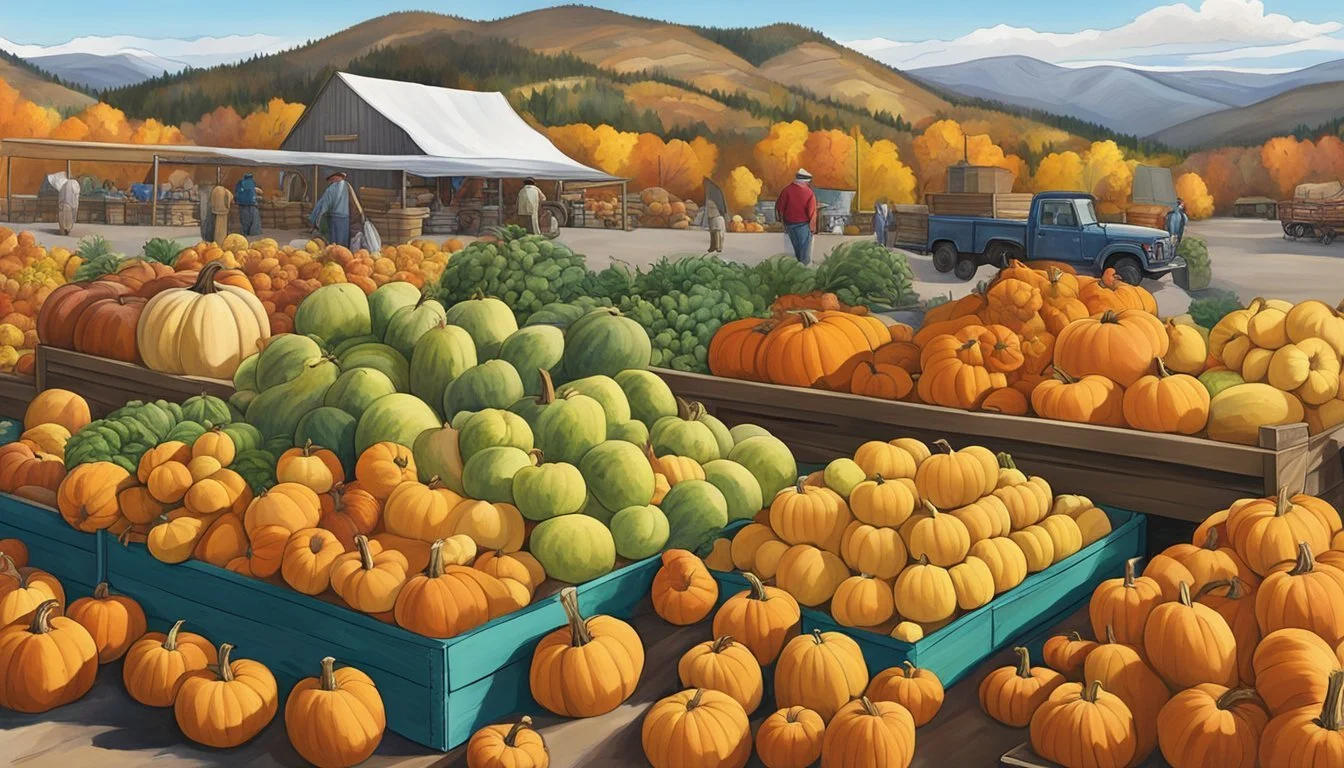Wyoming Seasonal Fruit & Vegetables in November
A Guide to Fresh Produce Selection
This Article is Part of our Wyoming Seasonal Fruit & Veg Calendar
As November ushers in the chill of late autumn, Wyoming's agricultural landscape transitions accordingly. Despite the state's cooler climate and shorter growing season, local farmers and gardeners harvest a variety of fruits (What wine goes well with fruit?) and vegetables during this month. Seasonal produce in November includes hearty root vegetables and a selection of greens that are capable of withstanding the early frosts. These crops not only offer the opportunity for fresh, farm-to-table eating but also embody the resilience of Wyoming's agricultural practices adapted to its specific climatic conditions.
In Wyoming, the frost-hardy produce that typically takes the spotlight includes staples such as potatoes, carrots, and turnips, all of which reach optimal maturity and flavor during the colder months. The state's harvest also boasts a range of leafy greens like kale and chard, as well as cruciferous vegetables like Brussels sprouts, which become sweeter with a touch of frost. This seasonal bounty provides ample ingredients for nourishing meals that suit the crisp weather.
For fruit, options are more limited due to the cold, but late apples and pears might still be found on the branches in early November. As the harvest season wanes, Wyoming's markets and kitchens pivot to celebrate these robust offerings, crafting dishes that align with the season's harvest and palette. The durability and versatility of November's produce selection are reflective of the state's hardy agricultural spirit.
Overview of Wyoming's Seasonal Produce
In November, Wyoming's seasonal produce transitions from the fall harvest into the early offerings of winter. This period provides a unique bounty that coincides with festive occasions such as Thanksgiving.
Importance of Seasonal Eating
Eating seasonally in Wyoming means enjoying fruits and vegetables at their peak of freshness and nutritional value. During November, seasonal eating also supports local agriculture and coincides with Thanksgiving preparations, offering a selection of produce ideal for traditional recipes. The shift from fall to winter sees a change in available crops, with most fruits already harvested and a focus on cold-hardy vegetables.
Season: Fall into Winter
Fruits: Sparse; most fruit harvests have concluded.
Vegetables: Selection includes:
Root vegetables: carrots, beets (how long do beets last?)
Winter squash: butternut, acorn
Hardy greens: kale, spinach
Harvest: The bulk of fruit harvests are complete, with vegetables taking center stage.
Thanksgiving: The harvest aligns with dishes traditionally served during Thanksgiving, incorporating nutrient-rich, hearty produce that can withstand colder temperatures.
Seasonal Fruits in November
November in Wyoming offers a harvest of fruit that excels in flavor and ripeness. Consumers can enjoy a variety of fruits that are at their best in terms of taste and nutritional value.
Apples
Wyoming's November chill encourages the harvest of multiple apple varieties. Apples like Granny Smith and Honeycrisp provide a balance between tart and sweet flavors, suitable for both eating raw and cooking. Braeburns are notable for their versatility and often recommended for their consistent quality.
Flavor: Ranges from tart (Granny Smith) to sweet (Honeycrisp)
Uses: Raw consumption, baking, sauces, and salads
Pears
As the apple harvest wanes, pears take center stage. Varieties such as Bartlett and Anjou pears are ripe for picking. They are known for their sweet, buttery flavors and are excellent in both raw and cooked dishes.
Flavor: Sweet and buttery
Texture: Soft yet firm enough to hold their shape when cooked
Cranberries
Although not largely grown in Wyoming, cranberries reach peak season around November. These tart berries are traditionally used to make cranberry sauce for Thanksgiving and are a staple in fall recipes.
Flavor: Tart and bold
Common uses: Cranberry sauce, juices, and as a tangy addition to baked goods
Pomegranates
Pomegranates are another fruit that finds its way into November’s seasonal bounty. Known for their jewel-like seeds, pomegranates add a sweet and tangy flavor to salads and are packed with nutrients.
Flavor: Sweet and tart
Benefits: Antioxidant-rich and visually appealing for garnishes and in salads
Seasonal Vegetables in November
November in Wyoming showcases a bountiful harvest of vegetables that thrive in cooler temperatures. The prominent categories include root vegetables, winter squash, and leafy greens, each rich in nutrients and flavor.
Root Vegetables
Root vegetables reach their peak during the fall. Beets, carrots, turnips, and parsnips, in particular, are widely available and offer a sweet, earthy taste that intensifies with roasting or boiling. These vegetables are ideal for warm, hearty dishes and can be stored well into winter due to their longer shelf life.
Beets: Rich in color and nutrients, excellent for roasting.
Carrots: Versatile and sweet, perfect for stews.
Turnips: Starchy and slightly spicy, ideal for mashing.
Parsnips: Subtly sweet, superb when pureed or added to soups.
Winter Squash
Winter squash varieties, such as pumpkins and butternut squash (how long does butternut squash last?), are hallmarks of the season. Their thick skin allows them to store well, and their sweet, nutty flavors are a perfect complement to many November dishes. Squash is often roasted, made into soups, or baked into pies, providing a comforting presence on the Wyoming table.
Pumpkins: Classic for pies and soups.
Butternut Squash: Smooth texture and sweet taste, ideal for a variety of recipes.
Leafy Greens
Leafy greens such as kale and chard are resilient through cool weather and bring a vibrant green to the table. They are nutrient-dense and versatile, suitable for salads, sautés, and as an addition to hearty grain dishes.
Kale: Robust and slightly peppery, it stands up well in cooked dishes.
Chard: Tender with a mild flavor, excellent for wilting into warm salads or pasta.
Incorporating these seasonal vegetables into meals not only supports local agriculture but also ensures the freshest, most flavorful produce can be enjoyed during the colder months.
Health Benefits of Seasonal Produce
Eating seasonal produce, particularly those available in Wyoming in November, offers substantial health benefits. Fruits and vegetables harvested at their peak are at their nutritional zenith and pack a flavorful punch that outshines out-of-season counterparts.
Nutritional Value
Seasonal fruits and vegetables boast higher degrees of vitamins and minerals since they are harvested at the optimal time. For instance, citrus fruits, common in November, are high in Vitamin C and fiber, key for immunity and digestive health. Root vegetables, which are also seasonal during this time, are abundant in Vitamin A and potassium, crucial for eyesight and cardiovascular health. The presence of antioxidants in these products can help protect the body from oxidative stress.
Vitamin C: essential for the growth, development, and repair of body tissues.
Fiber: promotes satiety and supports a healthy digestive system.
Potassium: vital for proper cell function and blood pressure regulation.
Magnesium: plays a role in over 300 enzyme reactions in the human body.
Vitamin A: important for vision and the immune system.
Beta-Carotene: an antioxidant that the body converts into Vitamin A.
Freshness and Flavor
The freshness of seasonal produce translates to a superior taste profile and higher levels of health-promoting compounds. Citrus fruits from November harvests in Wyoming not only provide a burst of flavor but also contain beta-carotene and magnesium, which support the maintenance of healthy skin and nerve function. When fruits and vegetables are consumed close to their harvest time, they retain more of their natural flavors and textures, enhancing the overall eating experience.
Citrus fruits: Exhibits a fresh and tangy profile, indicative of high antioxidant presence.
Root vegetables: Have a rich and earthy flavor, reflecting a dense nutrient composition including fiber and potassium.
Preparing and Cooking November Produce
In November, Wyoming's seasonal produce offers a rich palette of flavors ideal for comfort foods like soups and baked dishes. Effective storage and cooking techniques can enhance the taste and longevity of these ingredients.
Storage Tips
Wyoming's November produce includes root vegetables and hearty greens, which often require cool, dry storage.
Root Vegetables: Store potatoes, turnips, and sweet potatoes in a dark, cool area to prevent sprouting and spoilage. Avoid refrigeration as it can alter their flavor and texture.
Hardy Greens: Kale, chard, and collard greens (how long do collard greens last?) should be kept in a refrigerator's crisper drawer, wrapped loosely in a damp cloth or in perforated bags to maintain freshness.
Cooking Methods
Different cooking methods can bring out the natural sweetness or enhance the earthy flavors (What wine goes well with earthy flavors?) of November produce. Here are some optimal methods:
Roasting: Transform root vegetables like parsnips and squashes by roasting them to caramelize their natural sugars. A simple toss with olive oil, salt, and pepper will suffice.
Baking: Baking is perfect for sweets and treats using apples and pumpkins. These fruits hold up well when baked in pies or bread.
Soup and Stews: Utilize the full-bodied flavors of November vegetables in soups and stews. A slow simmer allows the ingredients' flavors to meld beautifully.
Recipe Ideas
Here are some specific recipe suggestions that showcase November produce:
Salad: A raw kale salad with apples and walnuts, dressed in a tangy vinaigrette, provides a crisp and refreshing side dish.
Roasted: Try roasted brussels sprouts with a balsamic glaze as a side – their outer leaves turn irresistibly crispy.
Cooked: Incorporate mashed sweet potatoes as a side dish or a base for shepherd's pie, enhancing the natural sweetness with a touch of cinnamon.
Baked: Bake an apple and cranberry crumble, making use of the tart and sweet flavors that epitomize the season's fruits.
Soup: Create a hearty butternut squash soup, seasoned with nutmeg and garnished with roasted pumpkin seeds (how long do pumpkin seeds last?) for texture.
Wyoming's Local Produce Availability
In Wyoming, November heralds the end of the traditional growing season, yet local produce remains accessible through farmers markets and grocery store selections, with a focus on storage crops and greenhouse-grown items.
Farmers Markets
Wyoming's farmers markets in November typically feature storage crops such as potatoes, onions, garlic, and various types of squash. These markets might have limited hours and availability due to the season, but consumers can still find a variety of locally grown produce. Here is a list of common items available:
Root vegetables: carrots, beets, parsnips
Winter squash: acorn, butternut, spaghetti
Cabbage family: Brussel sprouts, kale
Alliums: onions, garlic
Additionally, some markets offer greenhouse-grown greens like spinach and lettuce.
Grocery Store Selection
Grocery stores in Wyoming supplement local offerings with imported produce to ensure variety. However, they still stock local items, prominently displayed with signage indicating Wyoming-sourced produce. Shoppers can typically find:
Locally produced honey and preserves
Winter storage crops like those found at farmers markets
While the selection is naturally slimmer compared to the harvest months, grocery stores strive to support local producers and provide fresh, seasonal items.







